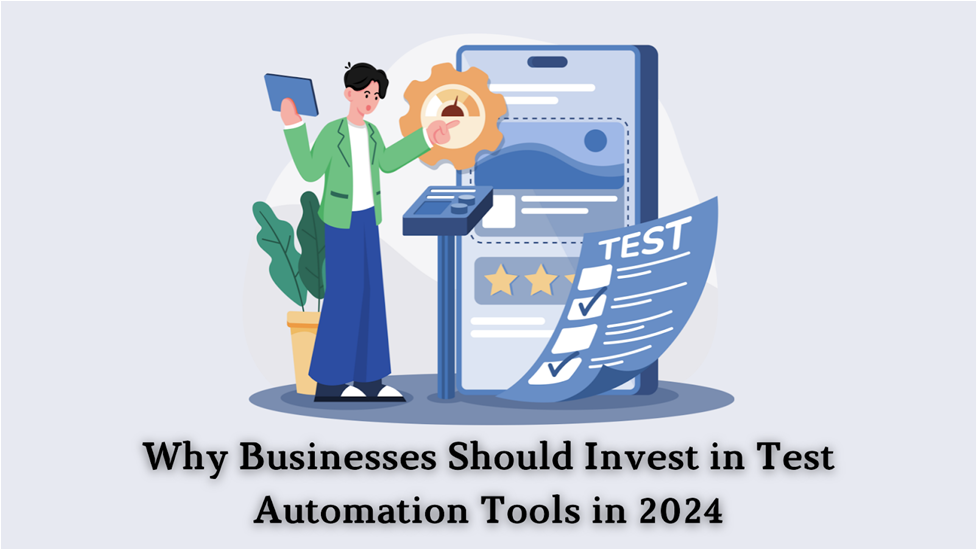Businesses are under immense pressure to quickly deliver high-quality software. This urgency has fundamentally transformed quality assurance and testing approaches, driving a significant shift toward automation.

As companies strive to meet tight deadlines without compromising on software quality, the reliance on test automation tools is becoming more critical than ever, reshaping industry standards and expectations.
This shift has led to the widespread adoption of AI test automation software, which accelerates the testing process by identifying and resolving issues more efficiently. Unlike manual testing, which is often labor-intensive and time-consuming, AI-driven test automation can rapidly execute test cases, providing faster feedback and allowing for quicker iterations. Manual testing requires human oversight to identify issues, while AI testing systems can detect patterns, predict potential failures, and even adapt to changes in code or user behavior, minimizing the chances of human error. Integrating AI into test automation enables teams to simulate complex scenarios, uncover hidden bugs, and ensure software reliability at scale. As a result, companies can maintain agility while delivering consistent quality, meeting the demands of a rapidly evolving digital landscape.
The Evolution of Testing in Modern Software Development
As businesses increasingly prioritize rapid, high-quality software releases, the landscape of quality assurance and testing has undergone a significant transformation. This shift centers around the integration of automation into testing processes, driven by the need to meet accelerating market demands efficiently.
With the rise of Agile and DevOps methodologies, automation testing has become an essential strategy, not just for enhancing speed but also for ensuring reliability and performance in final software products. As a result, the role of testing in software development continues to evolve, directly influencing the success and sustainability of technological innovations.
To effectively implement this type of testing, businesses need to research a range of tools that can handle various aspects of the testing process. From functional testing to performance and security testing tools like Functionize, Selenium, Cypress, and TestComplete are covering many functions to have an efficient end result. One tool can automate web application tests, while others focus on mobile or API testing. However, with so many options available businesses need to compare these tools to determine which ones align best with their specific needs and infrastructure. A comparison table of the best automation testing tools can help businesses evaluate the strengths and weaknesses of each solution, ensuring they choose the most suitable tool for their testing requirements.
Key Benefits of Integration in Modern Software Testing
Integrating test automation within the software development cycle offers significant advantages that streamline processes and enhance product quality. Here are some of the key benefits:
- Continuous Testing: Automation enables continuous testing throughout the development cycle, allowing teams to identify and address issues as they arise, rather than at the end of the development process. This integration ensures that products are always ready for deployment at any stage.
- Faster Feedback Loops for Developers: Automated tests provide immediate feedback to developers on the impact of their recent changes. This rapid response not only accelerates development cycles but also helps in quickly rectifying any faults, thereby reducing the time to market.
- Reduced Bottlenecks in the Deployment Pipeline: By automating tests, teams can reduce the bottlenecks often encountered during the manual testing phase. This smoother flow through the deployment pipeline facilitates quicker releases and more efficient use of resources.
- Improved Collaboration between Development and QA Teams: Test automation fosters better communication and collaboration between the development and QA teams. Shared automated test results can be easily accessed and understood by both teams, leading to a more cohesive environment and ultimately, a higher-quality software product.
Leading Test Automation Tools in 2024
Automated testing tools have become essential in ensuring software quality and efficiency. Here’s an overview of some leading tools that cater to various testing needs:
testRigor
- Type: End-to-end testing platform
- Features: AI-powered test creation, natural language test writing, cross-browser and cross-platform compatibility
- Benefits: Enhances ease of use with minimal coding requirement, ensures robust application performance across environments
- Ideal For: Teams seeking an innovative, user-friendly testing solution
Selenium
- Type: Open-source testing framework
- Features: Supports multiple browsers, integrates with various programming languages
- Benefits: Offers versatility and broad compatibility, ideal for web application testing
- Ideal For: Developers and testers looking for a reliable and established framework
Cypress
- Type: Modern web testing framework
- Features: Real-time reload capabilities
- Benefits: Speeds up testing with immediate feedback, simplifies setup and execution
- Ideal For: Teams needing fast and efficient testing for web applications
Appium
- Type: Mobile application testing tool
- Features: Supports automation of native, mobile web, and hybrid apps on iOS and Android
- Benefits: Facilitates testing across mobile platforms without altering apps
- Ideal For: Teams focusing on comprehensive mobile application testing
Unified Functional Testing (UFT)
- Type: Enterprise-level functional testing tool
- Features: Robust solutions for API, web, and mobile testing; powerful scripting capabilities
- Benefits: Allows for automation of complex test cases, supports extensive testing needs
- Ideal For: Enterprises requiring thorough, integrated testing solutions
These tools demonstrate the diversity and capability of current automated testing solutions, making them suitable for a variety of testing scenarios and requirements.
Cost-Benefit Analysis of Test Automation
Organizations are increasingly recognizing the financial benefits of test automation. Over 72% of companies now allocate between 10% and 49% of their overall QA budget to test automation, highlighting its perceived value.
ROI Comparison Table
| Metric | Manual Testing | Automated Testing |
| Initial Cost | Lower | Higher |
| Long-term Cost | Higher | Lower |
| Time to Execute 1000 Test Cases | ~160 hours | ~8 hours |
| Error Rate | 5-8% | <1% |
| Resource Requirements | High | Low after setup |
| Scalability | Limited | Highly Scalable |
Enhancing Accuracy and Reducing Human Error
Enhancing accuracy and reducing human error are central to the case for test automation. Automated testing significantly minimizes error rates, thus improving the precision of software releases.
Tools are particularly effective, leveraging AI-driven validation to identify issues that manual testers might overlook. Automation helps eliminate common mistakes such as data entry errors, inconsistencies in test execution, missed test steps, calculation errors, and documentation oversights, ensuring a more reliable testing process.
Scalability and Reusability of Automated Tests
Modern test automation tools like testRigor provide scalability and reusability that are essential for today’s dynamic software development environments. These tools allow teams to create test suites that are not only adaptable across various environments and platforms but also enhance the return on investment by extending the utility of each test created.
The benefits of scalable testing include the ability to accommodate expanding test suites as project requirements grow, support for multiple platforms and browsers, the capability to handle increased loads and stress testing efficiently, and the facilitation of parallel test execution. Additionally, these tools streamline test maintenance and updates, ensuring that test suites evolve alongside the software they are designed to assess.
Integration with Other Tools and Systems
The ability to integrate with existing development and deployment tools is crucial. Leading automation tools support seamless integration with:
- CI/CD pipelines
- Version control systems
- Bug tracking tools
- Project management platforms
- Performance monitoring systems
Compliance and Regulatory Standards
In regulated industries, consistent testing is non-negotiable. Automated testing tools help ensure:
- Regular compliance checks
- Audit trail maintenance
- Standardized testing procedures
- Documentation of test results
- Consistent security testing
Preparing for AI and Machine Learning Integrations
The future of test automation is increasingly intertwined with advancements in AI and ML technologies. Tools like testRigor are at the forefront of this evolution, utilizing these capabilities to enhance testing processes significantly. By predicting potential defects, these tools proactively address issues before they impact the development cycle.
AI also optimizes test case selection, ensuring that tests are both efficient and effective. Additionally, the ability to self-heal broken tests and generate relevant test data reduces downtime and enhances productivity. Ultimately, these innovations lead to improved test coverage, ensuring more robust software solutions.
Competitive Advantage in the Market
Test automation provides significant competitive advantages, like faster time to market by streamlining testing and speeding up iterations. It improves product quality by depth and consistency of testing, hence reducing overall development costs by keeping deep manual testing to a minimum.
One achieves improvement in customer satisfaction and better resource utilization when team members can concentrate on strategic work instead of repetitive testing, hence increasing overall productivity and innovation.
Final Thoughts
As 2024 unfolds, the imperative for businesses to adopt test automation tools is clear. The rapidly expanding market and innovations led by platforms like testRigor offer organizations advanced solutions that can revolutionize their testing procedures.
For companies aiming to stay ahead in a competitive landscape, leveraging these tools is essential for enhancing efficiency, improving software quality, and ultimately achieving greater customer satisfaction. Investing in test automation is not just strategic; it’s a necessity for future success.
Frequently Asked Questions
Is automation testing a good career in 2024?
Yes, automation testing is a thriving career in 2024, essential for efficient software development and quality assurance.
What is the future growth of automation testing?
Automation testing is expected to see significant growth, driven by advancements in AI and continuous delivery practices.
Is manual testing a good career in 2024?
Manual testing remains valuable, especially for exploratory, usability, and ad-hoc testing areas, complementing automated processes.



